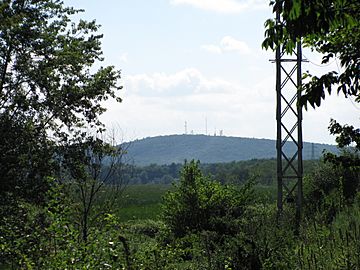Nobscot Hill facts for kids
Quick facts for kids Nobscot Hill |
|
|---|---|

View of Nobscot Hill from Wayland
|
|
| Highest point | |
| Elevation | 600 ft (180 m) |
| Geography | |
| Location | Middlesex County, Massachusetts |
| Topo map | USGS Framingham |
Nobscot Hill is a cool spot in Middlesex County, Massachusetts. It has lots of hiking trails for everyone to explore. This hill is located in both Framingham and Sudbury.
At the very top of Nobscot Hill, you'll find radio towers and a fire tower. Below the summit is the Nobscot Scout Reservation, a big area of 452 acres. This reservation includes a popular viewing spot called Tippling Rock. Around the hill, there are other large parks and protected lands. These include the Nobscot Conservation Land, Callahan State Park, Sudbury Weisblatt Conservation Land, and Wittenborg Woods. All these areas are connected by hiking trails, like the famous Bay Circuit Trail.
Contents
Exploring Nobscot Hill's Views
The top of Nobscot Hill offers amazing 360-degree views. You can see cities like Boston and the MetroWest area. On a clear day, you might even spot distant mountains like the Blue Hills, Lower Kearsarge, Mount Monadnock, and Mount Wachusett.
Right now, trees block some of the view from the summit. But if the fire tower is open, you can climb it for a better look! Other nearby spots, like Jethro's Table and Tippling Rock, give clear views towards Boston. Nobscot is surrounded by smaller hills too. To the west is Doeskin Hill, named long ago after someone lost a deerskin glove there. To the east is Tantamous Hill, named after a medicine man who lived on Nobscot.
Nobscot Hill's Rich History
The area around Nobscot Hill has a long and interesting past. By 1657, it was called "Penobscot," which means "Place of the Falling Rock." Later, the name was shortened to "Nobscot."
Native American Connections
Nobscot was a special place for the Nipmuc people. They lived in this area for many years. There was a large stone cairn (a pile of stones) at the summit. This cairn might have been used as a lookout point by the Native Americans. A Nipmuc medicine man named Tantamous, also known as Old Jethro, lived on Nobscot Hill. His son, Peter Jethro, and twelve others lived there too. They had orchards and cornfields on the sides of the hill. You can still see many large Native American grinding stones today.
In 1649, records mentioned "Jethro's Field" at Nobscot. Other fields like "Peter's Field" were also noted. Tippling Rock might have been used to send messages between Native American villages. In the early 1900s, this rock was split in half, possibly by a local farmer. The cairn, which was likely a lookout, was rebuilt in 1927. It was 8 feet wide and 5.5 feet tall.
Colonial Times and Early America
In the 1700s, a general from the Revolutionary War, John Nixon, lived and farmed on the north side of Nobscot Hill. You can still see the remains of his house. During a smallpox outbreak in 1792, a special house was built at the base of Nobscot. This "pest house" was for people who were sick. A small burial ground was also made for those who died. You can visit this cemetery and the old cellar hole today.
The land around Nobscot was used for farming for many years. The famous writer Henry David Thoreau visited Nobscot in the 1850s. He wrote about the hill and a waterfall nearby.
Henry Ford's Vision and the Boy Scouts
In the 1920s and 1930s, Henry Ford, who founded Ford Motor Company, bought hundreds of acres around Nobscot Hill. He also bought the Wayside Inn. Ford wanted to create an old American village, similar to Greenfield Village in Michigan. In the 1930s, he built a large dam at the base of the hill. This dam was meant to create a reservoir for fighting fires in his planned village. However, the dam didn't hold water well. It's now known as "Ford's Folly" and you can visit it on the hiking trails.
In 1928, the Boy Scouts bought a large reservation on Nobscot Hill. The Boy Scouts still own this land, but it is open to the public as invited guests. In 2008, a 303-acre part of the Nobscot Scout Reservation in Sudbury was permanently protected. This was done by the Sudbury Valley Trustees, the Town of Sudbury, and the Mayflower Council, Boy Scouts of America.
Images for kids
-
"Ford's Folly" dam built by Henry Ford near the base Nobscot Hill and across from the Wayside Inn in Sudbury











